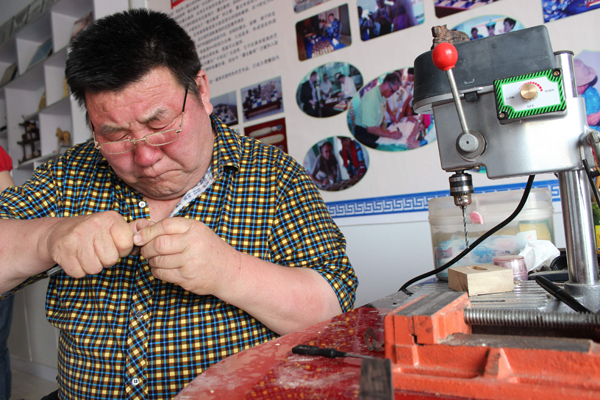
 |
|
Norbu, 60, works on a Mongolian chess piece called shatar, an intangible cultural heritage of the Inner Mongolian autonomous region. |
It is like chess, but this Mongolian cousin of the Western board game is different.
Norbu wears presbyopic glasses and stares at a tiny piece of wood. Beads of sweat ooze from his forehead when he focuses on carving the wood.
The 60-year-old ethnic Mongolian says he has been emotionally attached to the small pieces of wood since childhood.
"I was not allowed to touch the chess pieces when I was a child. The adults were afraid I would break these treasures," he recalls. "The shatar sets were antiques passed down through the generations because not many people knew how to make new ones."
But Norbu's eagerness to play shatar motivated him to try to make his own set, and he proved good at it. With a knife and a drill, what started off as hobby became an adventure of promoting the age-old tradition.
Shatar has ambiguous roots in the 13th century and is generally believed to derive from shatranj, a Persian game, which is also the embryo of modern chess. Shatar still keeps some of the original rules of shatranj. What distinguishes shatar from other chess variants are its chess pieces and slightly different rules.
Queens in shatar are shaped like lions or tigers. Bishops are replaced by camels. Pawns are carved into hounds while rooks look like carts.
"These are reflections of lives on grasslands," Norbu explains. "But there is no uniform shape for each piece. I can thus create a diverse variety of chessmen."
He says each handmade piece is unique because of the details, adding that he does not draw a blueprint before carving. Instead, he lets his imagination fly.
"Being a carver, I have to have brilliant eyesight. Details are of extreme importance. If I don't seek perfection, the shatar pieces will look rough, like those easily found in the market."
He sources his wood from old furniture because the price of some luxurious timber like red sandalwood is too expensive.
A set of handmade shatar will take more than two weeks to finish. He is overjoyed to find many collectors who are willing to spend more than 20,000 yuan ($3,200) per set.
| Former Residence of Hu Xueyan: beautiful and luxurious | Shanghai intangible cultural heritage showcased in Taipei |




 Former Residence of Hu Xueyan: beautiful and luxurious
Former Residence of Hu Xueyan: beautiful and luxurious Tibetan farmers in highland barley field
Tibetan farmers in highland barley field Shanghai intangible cultural heritage showcased in Taipei
Shanghai intangible cultural heritage showcased in Taipei Spending weekends in Dongjiangwan, China's Tianjin
Spending weekends in Dongjiangwan, China's Tianjin Shanxi cultural industry expo opens in Taiyuan
Shanxi cultural industry expo opens in Taiyuan